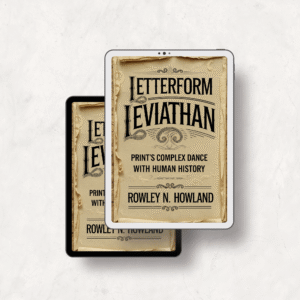Letterform Leviathan Book Review – Complete Guide to Print’s Cultural Impact and Typography History

Letterform Leviathan reveals the fascinating story of how printing technology revolutionized human communication and shaped our modern world. If you’ve ever wondered how typography influenced political revolutions, democratized knowledge, or empowered marginalized voices throughout history, this comprehensive exploration offers profound insights into print’s cultural impact. Unlike typical design books that focus purely on aesthetics, “Letterform Leviathan: Print’s Complex Dance With Human History” uncovers the deep connections between technological advancement and societal transformation.
This remarkable book traces the evolution of letterforms from Gutenberg’s revolutionary printing press to today’s digital typography, demonstrating how each technological breakthrough sparked cultural revolutions and reshaped human civilization. You’ll discover how printing technology became a catalyst for social justice movements, political upheavals, and artistic expression that continues to influence our digital age.
What You’ll Discover
- Revolutionary Print History: Explore how printing technology democratized knowledge and broke the monopoly of elite information control
- Typography as Cultural Expression: Learn how letterforms reflect and shape societal values, national identities, and political movements
- Social Transformation Through Print: Discover how newspapers, pamphlets, and books ignited political revolutions and social justice movements
- Communication Evolution Insights: Master the connections between historical print innovations and modern digital communication challenges
- Cultural Adaptation Strategies: Understand how different societies modified printing technologies to reflect their unique values and languages
- Artistic Expression Through Design: Appreciate the profound relationship between typography, graphic design, and creative communication
Why This Book Matters
The cultural impact of printing technology extends far beyond simple text reproduction. “Letterform Leviathan” demonstrates how typography and print design influenced everything from religious reformation to democratic movements, revealing patterns that help us understand today’s digital transformation. The book’s interdisciplinary approach connects technological innovation with political change, artistic expression, and social justice in ways that traditional design or history books rarely achieve.
Whether you’re a designer, historian, educator, or simply curious about how communication shapes society, this book provides essential context for understanding our current media landscape. The author’s expertise in both design and cultural analysis creates a unique perspective that makes complex historical developments accessible through engaging storytelling and concrete examples.
Key Features
This comprehensive ebook spans multiple chapters covering printing history, technological evolution, cultural adaptation, and artistic expression. Available as an instant digital download, you’ll receive immediate access to detailed analysis, historical examples, and thought-provoking insights. The format allows for easy reading on any device, with clear typography that honors the book’s subject matter. Also available as audiobook on Google Play Books and Spotify for convenient listening during commutes or workouts.
Frequently Asked Questions
How does this book differ from other typography and printing history books?
“Letterform Leviathan” takes an interdisciplinary approach that examines print’s cultural impact alongside technological development. While most books focus solely on design aesthetics or mechanical innovation, this comprehensive guide explores how printing technology triggered political revolutions, social movements, and cultural transformations that continue shaping our world today.
Is this book suitable for beginners interested in typography history and communication evolution?
Absolutely! The author presents complex historical developments through engaging storytelling and concrete examples that make print history accessible to all readers. Whether you’re a design professional or simply curious about how communication shapes society, the book’s conversational tone and clear explanations ensure everyone can appreciate these fascinating connections.
What practical applications does this printing technology history offer for modern professionals?
The book reveals timeless principles about communication, cultural adaptation, and social change that directly apply to today’s digital challenges. You’ll gain insights for enhancing digital communication strategies, understanding audience diversity, creating accessible resources, and learning from historical social movements to inspire contemporary activism and advocacy efforts.
Get Your Copy Today
Transform your understanding of communication evolution with this comprehensive guide to print’s cultural impact. Available for instant download at just $6.99, this ebook provides exceptional value compared to expensive design courses or university texts. Also available as audiobook on Google Play Books and Spotify. Purchase your copy through all major ebook retailers including Apple Books, Barnes & Noble, and Kobo to begin discovering how printing technology shaped human civilization today.
Watch the Video Review

